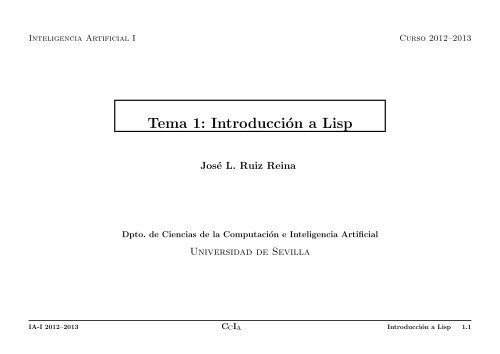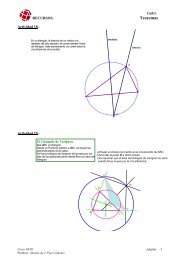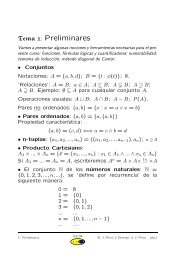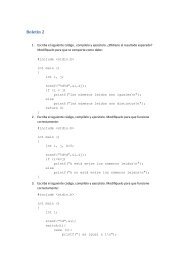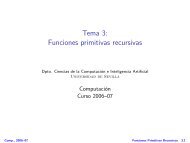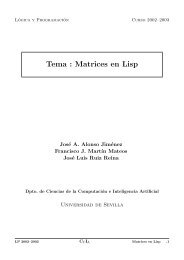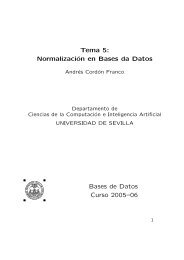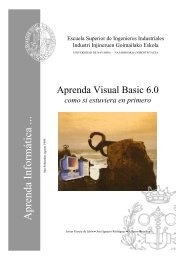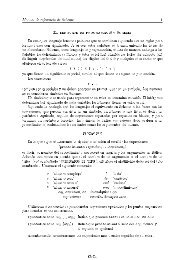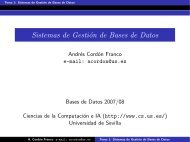Tema 1: Introducción a Lisp - Dpto. Ciencias de la Computación e ...
Tema 1: Introducción a Lisp - Dpto. Ciencias de la Computación e ...
Tema 1: Introducción a Lisp - Dpto. Ciencias de la Computación e ...
Create successful ePaper yourself
Turn your PDF publications into a flip-book with our unique Google optimized e-Paper software.
<strong>Introducción</strong> a <strong>Lisp</strong>1Historia: John McCarthy, 195811LISt Processing✉Lambda cálculoLenguaje interpretado✉Bucle lee, evalúa, escribe✉Compi<strong>la</strong>dor1Históricamente, uno <strong>de</strong> los lenguajes <strong>de</strong> <strong>la</strong> Inteligencia Artificial✉Procesamiento simbólico1Common <strong>Lisp</strong>: Clisp, GCL, CMUCL, Allegro. . .✉Usaremos clisp para <strong>la</strong>s prácticasIA-I 2012–2013 CcIa <strong>Introducción</strong> a <strong>Lisp</strong> 1.2
<strong>Introducción</strong> a <strong>Lisp</strong>1111Prototipado RápidoEficienciaParadigma <strong>de</strong> programación funcional✉Aunque no es puramente funcionalUn lenguaje <strong>de</strong> programación flexible✉Lenguaje <strong>de</strong> programación “programable”IA-I 2012–2013 CcIa <strong>Introducción</strong> a <strong>Lisp</strong> 1.3
<strong>Introducción</strong> a <strong>Lisp</strong>1Expresiones> 11> (+ 2 3)5> (+ (- 5 2) (* 3 3))121Primeras observaciones:✉Notación prefija: función y argumentos. Paréntesis. Expresiones anidadas✉Atomos y listas✉Sintácticamente simpleIA-I 2012–2013 CcIa <strong>Introducción</strong> a <strong>Lisp</strong> 1.5
<strong>Introducción</strong> a <strong>Lisp</strong>1Evaluación> (+ (- 5 2) (* 3 3))121Reg<strong>la</strong> <strong>de</strong> evaluación (básica)✉Evaluación <strong>de</strong> los argumentos✉De izquierda a <strong>de</strong>recha✉Los valores se pasan a <strong>la</strong> función1Todo se evalúa✉quote para evitar evaluaciones1Las formas especiales no siguen <strong>la</strong> reg<strong>la</strong> básica <strong>de</strong> evaluación✉Por ejemplo: if, cond,. . .✉Se verán más a<strong>de</strong><strong>la</strong>nteIA-I 2012–2013 CcIa <strong>Introducción</strong> a <strong>Lisp</strong> 1.6
<strong>Introducción</strong> a <strong>Lisp</strong>1La función quote:1> (quote (+ (- 5 2) (* 3 3)))(+ (- 5 2) (* 3 3))> ’(+ (- 5 2) (* 3 3))(+ (- 5 2) (* 3 3))Otro ejemplo:> x*** - EVAL: variable X has no value1. Break> abort> ’xX> (esto (es) (una lista))*** - EVAL: un<strong>de</strong>fined function ESTO1. Break> abort> ’(esto (es) (una lista))(ESTO (ES) (UNA LISTA))IA-I 2012–2013 CcIa <strong>Introducción</strong> a <strong>Lisp</strong> 1.7
<strong>Introducción</strong> a <strong>Lisp</strong>1111Entrada-Salida frente a evaluaciónSalida: función format> (format t "~a mas ~a igual a ~a. ~%" 2 3 (+ 2 3))2 mas 3 igual a 5.NILEntrada: función read> (<strong>de</strong>fun pi<strong>de</strong> (frase)(format t "~a " frase)(read))PIDE> (pi<strong>de</strong> "Su edad, por favor:")Su edad, por favor: 2323Algunas observaciones✉Lectura <strong>de</strong> expresiones <strong>Lisp</strong>✉Secuencialidad en programas✉Efectos co<strong>la</strong>teralesIA-I 2012–2013 CcIa <strong>Introducción</strong> a <strong>Lisp</strong> 1.8
<strong>Introducción</strong> a <strong>Lisp</strong>1Variables locales y globales> (let ((x 1) (y 2))(+ x y))3> x*** - EVAL: variable X has no value> (setf *glob* 3)*GLOB*> *glob*3IA-I 2012–2013 CcIa <strong>Introducción</strong> a <strong>Lisp</strong> 1.9
<strong>Introducción</strong> a <strong>Lisp</strong>1El paradigma <strong>de</strong> <strong>la</strong> programación funcional✉Valores vs. Modificaciones> (setf x ’(a b c d))(A B C D)> (remove ’b x)(A C D)> x(A B C D)1> (setf x (remove ’b x))(A C D)> x(A C D)La programación sin efectos co<strong>la</strong>terales es preferible aunque no obligatoria✉Los programas se comportan como funciones en el sentido matemático, <strong>de</strong>pendiendoexclusivamente <strong>de</strong> sus datos <strong>de</strong> entrada✉Verificación formalIA-I 2012–2013 CcIa <strong>Introducción</strong> a <strong>Lisp</strong> 1.10
Tipos <strong>de</strong> datos básicos1Atómicos:✉números: 27, 3.14, . . .✉símbolos: foo, FIRST, +, . . .✉caracteres: #\A, #\Space1No atómicos:✉Pares punteados y listas: (a . b), (a b c d e)✉Ca<strong>de</strong>nas: "Buenos días"✉Arrays: #(a b 0 nil), #3A(((0 0) (1 1) (2 2)) ((0 1) (1 2) (2 3)))✉Estructuras: #S(PERSONA :NOMBRE (ana maria) :ESTADO casado :CALLE (reinamerce<strong>de</strong>s) :CIUDAD sevil<strong>la</strong>)✉Tab<strong>la</strong>s hashIA-I 2012–2013 CcIa <strong>Introducción</strong> a <strong>Lisp</strong> 1.11
Pares y listas1Pares punteados:✉Construtor: cons✉Ejemplo: (cons 1 2) se evalúa al par (1 . 2)1 21Listas✉Un tipo especial <strong>de</strong> par punteado (pero el tipo <strong>de</strong> dato no atómico más común)✉Ejemplo: <strong>la</strong> lista (1 2 3)1 2 3IA-I 2012–2013 CcIa <strong>Introducción</strong> a <strong>Lisp</strong> 1.12nil
Funciones <strong>de</strong> construcción <strong>de</strong> listas1Funciones básicas <strong>de</strong> creación* (CONS X Y)(cons ’a ’b) => (A . B)(cons ’a ’(b c)) => (A B C)(cons ’a (cons ’b (cons ’c ’()))) => (A B C)(cons ’(a b) ’(c d)) => ((A B) C D)* (LIST X-1 ... X-N)(list ’a ’b ’c) => (A B C)(list ’(a b) ’(c d)) => ((A B) (C D))(list) => NIL(list (list ’a ’b)(list ’c ’d ’e)) => ((A B) (C D))* (APPEND L-1 ... L-N)(append ’(a) ’(b) ’(c) ’(x y)) => (A B C X Y)(append ’(a b) ’(c d)) => (A B C D)* (REVERSE L)(reverse ’(a (b c) d)) => (D (B C) A)IA-I 2012–2013 CcIa <strong>Introducción</strong> a <strong>Lisp</strong> 1.13
Funciones <strong>de</strong> acceso a listas* (FIRST L), (CAR L)(first ’(a b c)) => A(first ()) => NIL* (REST L), (CDR L)(rest ’(a b c)) => (B C)(rest ()) => NIL* (SECOND L)(second ’(a b c d)) => B(second ’(a)) => NIL* (NTH N L)(nth 2 ’(a b c d)) => C* (LENGTH L)(length ’(a (b c) d)) => 3* (SUBSEQ L I J)(subseq ’(a b c d e f g h) 2 5) => (C D E)IA-I 2012–2013 CcIa <strong>Introducción</strong> a <strong>Lisp</strong> 1.14
Números1Existen distintos tipos <strong>de</strong> números:✉Enteros: 14, 0, -7✉Racionales: 4/5, -2/1✉Coma flotante: 4.634, -.543✉Complejos: #C(3 46), #C(3.2, -5)> (/ 22 7)22/7> (round (/ 22 7))3 ;1/7> (float (/ 22 7))3.142857> #c(2 0)2IA-I 2012–2013 CcIa <strong>Introducción</strong> a <strong>Lisp</strong> 1.15
Funciones aritméticas* (+ X-1 ... X-N)(+ 3 7 5) => 15* (- X-1 ... X-N)(- 123 7 5) => 111(- 3) => -3* (* X-1 ... X-N)(* 2 7 5) => 70* (/ X Y)(/ 6 2) => 3(/ 5 2.0) => 2.5* (MOD X Y)(mod 7 2) => 1* (EXPT X Y)(expt 2 3) => 8* (SQRT X)(sqrt 16) => 4IA-I 2012–2013 CcIa <strong>Introducción</strong> a <strong>Lisp</strong> 1.16
Valores lógicos: T y NIL111El símbolo NIL tiene asociado el valor lógico ”falso”.✉() ≡ ’() ≡ NILEl símbolo T tiene asociado el valor lógico ”verda<strong>de</strong>ro”.✉Pero en general, cualquier elemento distinto <strong>de</strong> NIL tiene el valor lógico ”verda<strong>de</strong>ro”.Un predicado es una función que <strong>de</strong>vuelve un valor <strong>de</strong> verdad.> (listp ’(a b c))T> (listp 27)NIL> (and 3 4 5)5IA-I 2012–2013 CcIa <strong>Introducción</strong> a <strong>Lisp</strong> 1.17
Predicados aritméticos1Predicados aritméticos:* (= X-1 ... X-N)(= 2 2.0 (+ 1 1)) => T(= 1 2 1) => NIL* (> X-1 ... X-N)(> 4 3 2 1) => T(> 4 3 3 2) => NIL* (>= X-1 ... X-N)(>= 4 3 3 2) => T(>= 4 3 3 5) => NIL* (< X-1 ... X-N)* (
Predicados <strong>de</strong> tipos* (ATOM X)(atom 3) => T(atom ’ho<strong>la</strong>) => T(atom ’(1 2 3)) => NIL* (SYMBOLP X)(symbolp ’a) => T(symbolp 3) => NIL* (NUMBERP X)(numberp 4) => T(numberp 3.4) => T(numberp ’(1)) => NIL* (CONSP X)(consp ’(1 . 2))(consp nil)(consp ’(2 5))=> T=> NIL=> T* (NULL X)(null (rest ’(a b))) => NIL(null (rest ’(a))) => TIA-I 2012–2013 CcIa <strong>Introducción</strong> a <strong>Lisp</strong> 1.19
Predicados <strong>de</strong> igualdad* (EQ X Y)(eq 3 3) => T(eq 3 3.0) => NIL(eq 3.0 3.0) => NIL(eq (first ’(a b c)) ’a) => T(eq (cons ’a ’(b c)) ’(a b c)) => NIL* (EQL X Y)(eql 3.0 3.0) => T(eql (cons ’a ’(b)) (cons ’a ’(b))) => NIL* (EQUAL X Y)(equal (cons ’a ’(b)) (cons ’a ’(b))) => TIA-I 2012–2013 CcIa <strong>Introducción</strong> a <strong>Lisp</strong> 1.20
Expresiones condicionales1La forma especial IF:(IF )1Mecanismo <strong>de</strong> evaluación <strong>de</strong> un IF (forma especial):✉Evalúa :✉Si el valor es distinto <strong>de</strong> NIL (”verda<strong>de</strong>ro”) <strong>de</strong>vuelve el valor <strong>de</strong> ,✉en caso contrario <strong>de</strong>vuelve el valor <strong>de</strong> .1Ejemplo: (if (= y 0) 9999999 (/ x y))IA-I 2012–2013 CcIa <strong>Introducción</strong> a <strong>Lisp</strong> 1.21
Expresiones condicionales1La forma especial COND:(COND )✉: sucesión <strong>de</strong> expresiones <strong>de</strong> <strong>la</strong> forma()siendo una sucesión <strong>de</strong> expresiones <strong>Lisp</strong>.1Evaluación <strong>de</strong> un COND (forma especial):✉Evalúa los elemento hasta que aparece un valor distinto <strong>de</strong> NIL (”verda<strong>de</strong>ro”).✉Evalúa <strong>la</strong> correspondiente . Evalúa cada una <strong>de</strong> <strong>la</strong>s expresiones que<strong>la</strong> componen, <strong>de</strong>volviendo como el valor el último obtenido.✉Ejemplo:(cond((< x 3) (format t "Es peque~no") x)((< x 5) (format t "Es mediano") (* x 2))(t (* x x)))IA-I 2012–2013 CcIa <strong>Introducción</strong> a <strong>Lisp</strong> 1.22
Condicionales* (IF TEST ENTONCES [EN-CASO-CONTRARIO])(if (> 2 1) 1 2) => 1(if (> 1 2) 1) => NIL* (WHEN TEST E-1 ... E-N)(when (= 1 1) 1 2 3) => 3(when (= 1 2) 1 2 3) => NIL* (UNLESS TEST E-1 ... E-N)(unless (= 1 1) 1 2 3) => NIL(unless (= 1 2) 1 2 3) => 3* (COND L-1 ... L-N)> (<strong>de</strong>fun notas (n)(cond ((< n 5) ’suspenso)((< n 7) ’aprobado)((< n 9) ’notable)(t ’sobresaliente) ))NOTAS> (notas 8)NOTABLEIA-I 2012–2013 CcIa <strong>Introducción</strong> a <strong>Lisp</strong> 1.23
Operadores lógicos* (NOT X)(not (= (+ 1 1) 2)) => NIL(not (= (+ 1 1) 3)) => T* (OR E-1 ... E-N)(or nil 2 3) => 2(or (eq ’a ’b) (eq ’a ’c)) => NIL* (AND E-1 ... E-N)(and 1 nil 3) => NIL(and 1 2 3) => 3IA-I 2012–2013 CcIa <strong>Introducción</strong> a <strong>Lisp</strong> 1.24
Predicado <strong>de</strong> pertenencia y listas <strong>de</strong> asociación11Pertenencia:* (MEMBER E L [:TEST #’PREDICADO])(member ’x ’(a x b x c)) => (X B X C)(member ’x ’(a (x) b))=> NIL(setf l ’((a b) (c d))) => ((A B) (C D))(member ’(c d) l)=> NIL(member 2.0 ’(1 2 3))=> NIL(member ’(c d) l :test #’equal) => ((C D))(member 2.0 ’(1 2 3) :test #’=) => (2 3)(member 2.0 ’(1 2 3) :test #’ (3)Listas <strong>de</strong> asociación:* (ASSOC ITEM A-LISTA [:TEST PREDICADO])(assoc ’b ’((a 1) (b 2) (c 3))) => (B 2)(assoc ’(b) ’((a 1) ((b) 1) (c d))) => NIL(assoc ’(b) ’((a 1) ((b) 1) (c d)) :test #’equal) => ((B) 1)IA-I 2012–2013 CcIa <strong>Introducción</strong> a <strong>Lisp</strong> 1.25
Variables locales* (LET ((VAR-1 VAL-1)...(VAR-M VAL-M)) E-1 ... E-N)(setf a 9 b 7) => 7(let ((a 2)(b 3)) (+ a b)) => 5(+ a b) => 16(let ((x 2)(y (+ 1 x))) (+ x y)) => Error* (LET* ((VAR-1 VAL-1) ... (VAR-N VAL-N)) E-1 ... E-M)(let* ((x 2)(y (+ 1 x))) (+ x y)) => 5IA-I 2012–2013 CcIa <strong>Introducción</strong> a <strong>Lisp</strong> 1.26
Definiendo funciones1La forma especial DEFUN(DEFUN ())✉: símbolo al que se asocia <strong>la</strong> función.✉: sucesión <strong>de</strong> símbolos a los que se asignará, temporalmente, el valor<strong>de</strong> los argumentos con los que se utilice <strong>la</strong> función.✉: ca<strong>de</strong>na en <strong>la</strong> que se <strong>de</strong>scribe <strong>la</strong> función. Es opcional.✉: sucesión <strong>de</strong> expresiones que se evalúan cuando se utiliza <strong>la</strong> función.IA-I 2012–2013 CcIa <strong>Introducción</strong> a <strong>Lisp</strong> 1.27
Definiendo funciones1Ejemplo:> (<strong>de</strong>fun cuadrado (x) "Cuadrado <strong>de</strong> un numero" (* x x))CUADRADO1(cuadrado 4) se evalúa a 16:✉Se evalúa cuadrado: función <strong>de</strong>finida por el usuario.✉Se evalúa 4: 4✉Se asocia al parámetro <strong>de</strong> cuadrado, x, el valor 4.✉Se evalúa <strong>la</strong> expresión que compone el cuerpo <strong>de</strong> cuadrado:✉Se evalúa *: función primitiva <strong>de</strong> <strong>Lisp</strong> para calcu<strong>la</strong>r el producto.✉Se evalúa x: 4✉Se evalúa x: 4✉Se calcu<strong>la</strong> el producto con argumentos 4 y 4: 16✉Se elimina <strong>la</strong> asociación <strong>de</strong>l parámetro.IA-I 2012–2013 CcIa <strong>Introducción</strong> a <strong>Lisp</strong> 1.28
Definiciones recursivas1Recursión> (<strong>de</strong>fun factorial (n)(if (= n 0)1(* n (factorial (- n 1)))))FACTORIAL> (factorial 3)6IA-I 2012–2013 CcIa <strong>Introducción</strong> a <strong>Lisp</strong> 1.29
Traza <strong>de</strong> una recursión> (trace factorial *)(FACTORIAL *)> (factorial 2)1. Trace: (FACTORIAL ’2)2. Trace: (FACTORIAL ’1)3. Trace: (FACTORIAL ’0)3. Trace: FACTORIAL ==> 13. Trace: (* ’1 ’1)3. Trace: * ==> 12. Trace: FACTORIAL ==> 12. Trace: (* ’2 ’1)2. Trace: * ==> 21. Trace: FACTORIAL ==> 22> (untrace)(* FACTORIAL)1En general, TRACE (y UNTRACE) son herramientas útiles para <strong>de</strong>puraciónIA-I 2012–2013 CcIa <strong>Introducción</strong> a <strong>Lisp</strong> 1.30
Patrones comunes <strong>de</strong> recursión1Descen<strong>de</strong>nte numérico:(<strong>de</strong>fun f(... n ...)(if (= 0 n)))1Ejemplo:(<strong>de</strong>fun factorial(n)(if (= 0 n)1(* n (factorial (- n 1)))))IA-I 2012–2013 CcIa <strong>Introducción</strong> a <strong>Lisp</strong> 1.31
Patrones comunes <strong>de</strong> recursión1Listas lineales:(<strong>de</strong>fun f(... l ...)(if (endp l)))1Ejemplo:(<strong>de</strong>fun suma-lista(l)(if (endp l)0(+ (first l)(suma-lista (rest l)))))IA-I 2012–2013 CcIa <strong>Introducción</strong> a <strong>Lisp</strong> 1.32
Ejemplos <strong>de</strong> recursión en <strong>Lisp</strong>1Ejemplo: función subconjunto;;; (SUBCONJUNTO L1 L2);;; > (subconjunto () ’(s 3 e 4));;; T;;; > (subconjunto ’(4 3) ’(s 3 e 4));;; T;;; > (subconjunto ’(4 a 3) ’(s 3 e 4));;; NIL(<strong>de</strong>fun subconjunto (l1 l2)(if (endp l1)t(and (member (first l1) l2)(subconjunto (rest l1) l2))))IA-I 2012–2013 CcIa <strong>Introducción</strong> a <strong>Lisp</strong> 1.33
Ejemplos <strong>de</strong> recursión en <strong>Lisp</strong>1Ejemplo: función elimina-uno;;; (ELIMINA-UNO X L);;; > (elimina-uno 3 ’(a b c d));;; (A B C D);;; > (elimina-uno ’b ’(a b c d));;; (A C D);;; > (elimina-uno ’b ’(a b c b d));;; (A C B D)(<strong>de</strong>fun elimina-uno (x l)(cond ((endp l) l)((equal x (first l)) (rest l))(t (cons (first l) (elimina-uno x (rest l))))))IA-I 2012–2013 CcIa <strong>Introducción</strong> a <strong>Lisp</strong> 1.34
Ejemplos <strong>de</strong> recursión en <strong>Lisp</strong>1Ejemplo: función permutacion;;; (PERMUTACION L1 L2);;; > (permutacion ’(x 1 3 4) ’(3 2 x 4));;; NIL;;; > (permutacion ’(x 2 3 4) ’(3 2 x 4));;; T;;; > (permutacion ’(x 2 3 4) ’(3 2 x 4 4));;; NIL(<strong>de</strong>fun permutacion (l1 l2)(cond ((endp l1) (endp l2))((member (car l1) l2)(permutacion (rest l1)(elimina-uno (car l1) l2)))(t nil)))IA-I 2012–2013 CcIa <strong>Introducción</strong> a <strong>Lisp</strong> 1.35
Ejemplos <strong>de</strong> recursión en <strong>Lisp</strong>1Recursión cruzada: funciones par-p e impar-p;;; (PAR-P N), (IMPAR-P N);;; > (par-p 4);;; T;;; > (impar-p 10);;; NIL(<strong>de</strong>fun par-p (n)(cond ((= n 0) t)((= n 1) nil)(t (impar-p (- n 1)))))(<strong>de</strong>fun impar-p (n)(cond ((= n 0) nil)((= n 1) t)(t (par-p (- n 1)))))IA-I 2012–2013 CcIa <strong>Introducción</strong> a <strong>Lisp</strong> 1.36
Ejempos <strong>de</strong> recursión en <strong>Lisp</strong>1Ejemplo: función comprime;;; (COMPRIME LISTA);;; > (comprime ’(a a b c c c a d d d d d e));;; ((2 A) B (3 C) A (5 D) E);;; > (comprime ’(a b c c a d e));;; (A B (2 C) A D E)(<strong>de</strong>fun comprime (l)(if (consp l) (comprime-aux (first l) 1 (rest l)) l))(<strong>de</strong>fun comprime-aux (x n l)(if (endp l)(list (n-elementos x n))(let ((siguiente (car l)))(if (eql x siguiente)(comprime-aux x (+ n 1) (rest l))(cons (n-elementos x n)(comprime-aux siguiente 1 (rest l)))))))(<strong>de</strong>fun n-elementos (x n) (if (> n 1) (list n x) x))IA-I 2012–2013 CcIa <strong>Introducción</strong> a <strong>Lisp</strong> 1.37
El operador básico <strong>de</strong> iteración: DO1Ejemplo:(<strong>de</strong>fun lista-cuadrados (ini fin)(do ((i ini (1+ i)))((> i fin) ’terminado)(format t "~a ~a~%" i (* i i))))✉La primera parte <strong>de</strong>l do especifica <strong>la</strong>s variables <strong>de</strong>l bucle (i en este caso), su valorinicial (ini) y cómo se actualiza en cada iteración (se incrementa en uno)✉La segunda parte especifica <strong>la</strong> condición <strong>de</strong> parada ((>i fin)) y lo que se <strong>de</strong>vuelve(’terminado)✉Finalmente, <strong>la</strong> expresión final especifica qué hacer en cada iteración (escribir unalínea con i y con el cuadrado <strong>de</strong> i)IA-I 2012–2013 CcIa <strong>Introducción</strong> a <strong>Lisp</strong> 1.38
El operador básico <strong>de</strong> iteración: DO1Sesión:> (lista-cuadrados 1 5)1 12 43 94 165 25TERMINADO1Otro ejemplo, en el que se manejan varias variables(<strong>de</strong>fun factorial (n)(do ((j n (1- j))(f 1 (* j f)))((= j 0) f)))✉Nota: no hay asignaciones explícitasIA-I 2012–2013 CcIa <strong>Introducción</strong> a <strong>Lisp</strong> 1.39
El operador básico <strong>de</strong> iteración: DO1Otro ejemplo:;;; (ESPECULAR LISTA);;; > (especu<strong>la</strong>r ’(a b c c b a));;; T;;; > (especu<strong>la</strong>r ’(a b c g h h g c d a));;; NIL(<strong>de</strong>fun especu<strong>la</strong>r (l)(let ((long (length l)))(and (evenp long)(do ((<strong>de</strong>l 0 (1+ <strong>de</strong>l))(atr (1- long) (1- atr)))((or (> <strong>de</strong>l atr)(not (eq (nth <strong>de</strong>l l) (nth atr l))))(> <strong>de</strong>l atr))))))IA-I 2012–2013 CcIa <strong>Introducción</strong> a <strong>Lisp</strong> 1.40
Las macros DOLIST y DOTIMES11Ejemplo (con dolist y return):> (dolist (x ’(a b c d e))(format t "~a " x)(if (eq x ’c) (return ’ya)))A B CYAEjemplo (con dotimes):> (dotimes (x 5 x)(format t "~a " x))0 1 2 3 45IA-I 2012–2013 CcIa <strong>Introducción</strong> a <strong>Lisp</strong> 1.41
Bucles con LOOP1Ejemplos <strong>de</strong> uso <strong>de</strong> LOOP:> (loop for x from 1 to 7 collect (* x x))(1 4 9 16 25 36 49)> (loop for x from 1 to 7when (evenp x)collect (* x x))(4 16 36)> (loop for x from 1 to 7when (evenp x)summing (* x x))56> (loop for x from 1 to 7 by 2 collect (* x x))(1 9 25 49)> (loop for x in ’(1 3 5) summing x)9> (loop for l in’((a b c) (d e f) (g h i))append l)(A B C D E F G H I)IA-I 2012–2013 CcIa <strong>Introducción</strong> a <strong>Lisp</strong> 1.42
Bucles con LOOP1Ejemplos:> (<strong>de</strong>fun factor (x)(or (loop for i from 2 to (sqrt x)thereis (when (= (mod x i) 0)i))x))FACTOR> (factor 35)5> (<strong>de</strong>fun es-primo (x)(= x (factor x)))ES-PRIMO> (es-primo 7)T> (es-primo 35)NIL> (loop for x from 2 to 100count (es-primo x))25IA-I 2012–2013 CcIa <strong>Introducción</strong> a <strong>Lisp</strong> 1.43
Bucles con LOOP> (<strong>de</strong>fun primos-gemelos (x)(when (and (es-primo x)(es-primo (+ x 2)))(list x (+ x 2))))PRIMOS-GEMELOS> (loop for i from 200 to 2000thereis (primos-gemelos i))(227 229)> (loop for x from 2 to 100count (primos-gemelos x))8IA-I 2012–2013 CcIa <strong>Introducción</strong> a <strong>Lisp</strong> 1.44
Bucles con LOOP11Opciones iniciales:(LOOP FOR FROM TO ...)(LOOP FOR FROM TO BY ...)(LOOP FOR IN ...)(LOOP WHILE ...)(LOOP UNTIL ...)Opciones centrales:(LOOP ... WHEN ...)1Opciones finales:(LOOP ... DO )(LOOP ... COLLECT )(LOOP ... APPEND )(LOOP ... THEREIS )(LOOP ... COUNT )(LOOP ... SUMMING )IA-I 2012–2013 CcIa <strong>Introducción</strong> a <strong>Lisp</strong> 1.45
Escritura1La función format:(FORMAT DESTINO CADENA-DE-CONTROL X-1 ... X-N)> (format t "~&Linea 1 ~%Linea 2")Linea 1Linea 2NIL> (format t "~&El cuadrado <strong>de</strong> ~a es ~a" 3 (* 3 3))El cuadrado <strong>de</strong> 3 es 9NIL> (setf l ’(a b c))(A B C)> (format t"~&La longitud <strong>de</strong> <strong>la</strong> lista ~a es ~a"l (length l))La longitud <strong>de</strong> <strong>la</strong> lista (A B C) es 3NILIA-I 2012–2013 CcIa <strong>Introducción</strong> a <strong>Lisp</strong> 1.46
Escritura1Algunas directivas <strong>de</strong> <strong>la</strong> función format:~a escribe el siguiente argumento~&comienza nueva línea,si no está al comienzo <strong>de</strong> una~% comienza nueva línea~Naescribe el siguiente argumentomás los espacios suficientes paraocupar N caracteres <strong>de</strong> anchoIA-I 2012–2013 CcIa <strong>Introducción</strong> a <strong>Lisp</strong> 1.47
Lectura1La función read(READ)> (read)aA> (setf a (read))22> a2> (* (+ (read) (read))347> (read)(+ 2 3)(+ 2 3)IA-I 2012–2013 CcIa <strong>Introducción</strong> a <strong>Lisp</strong> 1.48
Lectura1read no evalúa. Función eval:(EVAL EXPRESION)> (eval (read))(+ 2 2)41Ejemplo:(<strong>de</strong>fun calcu<strong>la</strong>-cuadrados ()(loop(let ((aux (read)))(if (numberp aux)(format t "~&El cuadrado <strong>de</strong> ~a es ~a~%"aux (* aux aux))(return ’fin)))))IA-I 2012–2013 CcIa <strong>Introducción</strong> a <strong>Lisp</strong> 1.49
Matrices1Creación:(MAKE-ARRAY DIMENSIONES[:INITIAL-CONTENTS EXPRESION])> (make-array ’(2 2))#2A((NIL NIL) (NIL NIL))> (make-array ’(2 2 1))#3A(((NIL) (NIL)) ((NIL) (NIL)))> (make-array ’(2 2) :initial-element 2)#2A((2 2) (2 2))> (make-array ’(3 3):initial-contents ’((a b c)(1 2 3)(x y z)))#2A((A B C) (1 2 3) (X Y Z))> (setf *matriz*(make-array ’(3 3):initial-contents ’((a b c)(1 2 3)(x y z))))#2A((A B C) (1 2 3) (X Y Z))IA-I 2012–2013 CcIa <strong>Introducción</strong> a <strong>Lisp</strong> 1.50
Matrices11Acceso:(AREF MATRIZ INDICE-1 ... INDICE-N)> *matriz*#2A((A B C) (1 2 3) (X Y Z))> (aref *matriz* 0 0)A> (aref *matriz* 1 1)2> (aref *matriz* 2 2)ZModificación:(SETF (AREF MATRIZ INDICE-1 ... INDICE-N) EXPRESION)> *matriz-2*#2A((1 2 3) (8 H 4) (7 6 5))> (setf (aref *matriz-2* 1 2) ’h)H> (setf (aref *matriz-2* 1 1) 4)4> *matriz-2*#2A((A B C) (1 4 H) (X Y Z))IA-I 2012–2013 CcIa <strong>Introducción</strong> a <strong>Lisp</strong> 1.51
Matrices1Ejemplo;;; (SUMA-COLUMNAS MATRIZ);;; > (setf mat;;; (make-array ’(3 3);;; :initial-contents;;; ’((1 2 3) (4 5 6) (7 8 9))));;; #2A((1 2 3) (4 5 6) (7 8 9));;; > (suma-columnas mat);;; #(12 15 18)(<strong>de</strong>fun suma-columnas (a)(let* ((dim (array-dimensions a))(f (first dim))(c (second dim))(res (make-array (list c))))(loop for i from 0 to (- c 1)do (setf (aref res i)(loop for j from 0 to (- f 1)summing (aref a j i))))res))IA-I 2012–2013 CcIa <strong>Introducción</strong> a <strong>Lisp</strong> 1.52
Estructuras (ejemplo)> (<strong>de</strong>fstruct persona(nombre nil)(estado ’casado)(calle nil)(ciudad ’Sevil<strong>la</strong>))PERSONA> (setf ejemplo-1(make-persona :nombre ’ana :calle ’(Reina Merce<strong>de</strong>s)))#S(PERSONA :NOMBRE ANA :ESTADO CASADO :CALLE (REINA MERCEDES) :CIUDAD SEVILLA)> (setf ejemplo-2(make-persona :nombre ’pepe :ciudad ’Huelva))#S(PERSONA :NOMBRE PEPE :ESTADO CASADO :CALLE NIL :CIUDAD HUELVA)> (persona-ciudad ejemplo-1)SEVILLA> (persona-nombre ejemplo-2)PEPE> (setf (persona-nombre ejemplo-1) ’(Ana Maria))(ANA MARIA)> ejemplo-1#S(PERSONA :NOMBRE (ANA MARIA) :ESTADO CASADO:CALLE (REINA MERCEDES) :CIUDAD SEVILLA)IA-I 2012–2013 CcIa <strong>Introducción</strong> a <strong>Lisp</strong> 1.53
Estructuras (ejemplo)> (setf ejemplo-3 ejemplo-1)#S(PERSONA :NOMBRE (ANA MARIA) :ESTADO CASADO:CALLE (REINA MERCEDES) :CIUDAD SEVILLA)> (setf (persona-calle ejemplo-3) ’(tetuan))(TETUAN)> ejemplo-3#S(PERSONA :NOMBRE (ANA MARIA) :ESTADO CASADO:CALLE (TETUAN) :CIUDAD SEVILLA)> ejemplo-1#S(PERSONA :NOMBRE (ANA MARIA) :ESTADO CASADO:CALLE (TETUAN) :CIUDAD SEVILLA)> (setf ejemplo-4 (copy-persona ejemplo-2))#S(PERSONA :NOMBRE PEPE :ESTADO CASADO :CALLE NIL :CIUDAD HUELVA)> (setf (persona-ciudad ejemplo-4) ’cadiz)CADIZ> ejemplo-4#S(PERSONA :NOMBRE PEPE :ESTADO CASADO :CALLE NIL :CIUDAD CADIZ)> ejemplo-2#S(PERSONA :NOMBRE PEPE :ESTADO CASADO :CALLE NIL :CIUDAD HUELVA)IA-I 2012–2013 CcIa <strong>Introducción</strong> a <strong>Lisp</strong> 1.54
Estructuras111Creación <strong>de</strong> estructuras con <strong>de</strong>fstruct:(DEFSTRUCT (NOMBRE (:CONSTRUCTOR FUNCION-CONSTRUCTURA)(:CONC-NAME PREFIJO-)(:PRINT-FUNCTION FUNCION-DE-ESCRITURA))CAMPO-1...CAMPO-N)Ejemplo (puntos en el p<strong>la</strong>no):(<strong>de</strong>fstruct (punto (:constructor crea-punto)(:conc-name coor<strong>de</strong>nada-)(:print-function escribe-punto)xy)Ejemplo (función <strong>de</strong> escritura):(<strong>de</strong>fun escribe-punto (punto &optional (canal t) profundidad)(format canal "Punto <strong>de</strong> abcisa ~a y or<strong>de</strong>nada ~a"(coor<strong>de</strong>nada-x punto)(coor<strong>de</strong>nada-y punto)))IA-I 2012–2013 CcIa <strong>Introducción</strong> a <strong>Lisp</strong> 1.55
Estructuras (ejemplo)> (setf *punto-1* (crea-punto :x 2 :y 3))Punto <strong>de</strong> abcisa 2 y or<strong>de</strong>nada 3> (coor<strong>de</strong>nada-y *punto-1*)3> (setf (coor<strong>de</strong>nada-y *punto-1*) 5)5> *punto-1*Punto <strong>de</strong> abcisa 2 y or<strong>de</strong>nada 5> (punto-p *punto-1*)T> (punto-p ’(2 5))NILIA-I 2012–2013 CcIa <strong>Introducción</strong> a <strong>Lisp</strong> 1.56
Estructuras (ejemplo)> (setf *punto-2* (copy-punto *punto-1*))Punto <strong>de</strong> abcisa 2 y or<strong>de</strong>nada 5> (equal *punto-1* *punto-2*)NIL> (equalp *punto-1* *punto-2*)T> (setf (coor<strong>de</strong>nada-y *punto-2*) 3)3> *punto-2*Punto <strong>de</strong> abcisa 2 y or<strong>de</strong>nada 3> (setf *punto-3* (crea-punto :y 3 :x 2))Punto <strong>de</strong> abcisa 2 y or<strong>de</strong>nada 3> (equalp *punto-2* *punto-3*)TIA-I 2012–2013 CcIa <strong>Introducción</strong> a <strong>Lisp</strong> 1.57
Listas, matrices y tab<strong>la</strong>s hash1Las matrices no son tan flexibles como <strong>la</strong>s listas, pero permiten accesorápido a sus componentes y ahorran espacio✉Ventajas: acceso y actualización en tiempo constante✉Inconveniente: al crear un array necesitamos reservar el espacio <strong>de</strong> antemano1Una buena solución que permite utilización dinámica <strong>de</strong>l espacio y accesoy actualizaciones rápidas son <strong>la</strong>s tab<strong>la</strong>s hash✉Las tab<strong>la</strong>s hash almacenan asociaciones (c<strong>la</strong>ve,valor)✉La c<strong>la</strong>ve pue<strong>de</strong> ser <strong>de</strong> cualquier tipo (números, símbolos, funciones,...)IA-I 2012–2013 CcIa <strong>Introducción</strong> a <strong>Lisp</strong> 1.58
Tab<strong>la</strong>s hash11Creación (MAKE-HASH-TABLE):> (setf *tab<strong>la</strong>* (make-hash-table))#S(HASH-TABLE EQL)Acceso y actualización (GETHASH):> (gethash ’color *tab<strong>la</strong>*)NIL ;NIL> (setf (gethash ’color *tab<strong>la</strong>*) ’rojo)ROJO> (setf (gethash ’tal<strong>la</strong> *tab<strong>la</strong>*) ’gran<strong>de</strong>)GRANDE> (gethash ’color *tab<strong>la</strong>*)ROJO ;TIA-I 2012–2013 CcIa <strong>Introducción</strong> a <strong>Lisp</strong> 1.59
Tab<strong>la</strong>s hash11Borrado <strong>de</strong> asociaciones (REMHASH):[13]> (gethash ’tal<strong>la</strong> *tab<strong>la</strong>*)GRANDE ;T[14]> (remhash ’tal<strong>la</strong> *tab<strong>la</strong>*)T[15]> (gethash ’tal<strong>la</strong> *tab<strong>la</strong>*)NIL ;NILIterando sobre tab<strong>la</strong>s hash (MAPHASH):> (setf (gethash ’forma *tab<strong>la</strong>*) ’redonda(gethash ’precio *tab<strong>la</strong>*) 150)150> (maphash #’(<strong>la</strong>mbda (k v) (format t "~a = ~a~%" k v)) *tab<strong>la</strong>*)PRECIO = 150FORMA = REDONDACOLOR = ROJONILIA-I 2012–2013 CcIa <strong>Introducción</strong> a <strong>Lisp</strong> 1.60
Argumentos c<strong>la</strong>ve y opcionales1Argumentos opcionales(<strong>de</strong>fun factorial (n &optional (resultado 1))(if (= n 0)resultado(factorial (- n 1) (* n resultado))))(factorial 3) => 6(factorial 3 4) => 241Argumentos c<strong>la</strong>ve(<strong>de</strong>fun f (&key (x 1) (y 2))(list x y))(f :x 5 :y 3) => (5 3)(f :y 3 :x 5) => (5 3)(f :y 3) => (1 3)(f) => (1 2)IA-I 2012–2013 CcIa <strong>Introducción</strong> a <strong>Lisp</strong> 1.61
Valores <strong>de</strong> un símbolo1Hemos visto:DATOS EN LISP:- Números: 3, 2.5, 14.3, ...- Ca<strong>de</strong>nas: "ho<strong>la</strong>", "el perro come", ...- Símbolos: adios, fun, fact, cuadrado, ...- Listas: (1 s 3), (1 (a (b))), ...- Estructuras- Matrices, etc.1Un nuevo tipo <strong>de</strong> dato: funciones.✉Expresadas mediante <strong>la</strong>mbda(<strong>la</strong>mbda (x) (* x x))(<strong>la</strong>mbda (x y) (cond ((> x 0) 1)((< x 0) -1)(t 0)))IA-I 2012–2013 CcIa <strong>Introducción</strong> a <strong>Lisp</strong> 1.62
Valores <strong>de</strong> un símbolo1Estos datos funcionales se pue<strong>de</strong>n asignar a símbolos:> (setf (symbol-value ’cuadrado) 8)8> (setf (symbol-function ’cuadrado)(<strong>la</strong>mbda (x) (* x x)))#1Usualmente:> (setf cuadrado 8)8> (<strong>de</strong>fun cuadrado (x) (* x x))CUADRADOIA-I 2012–2013 CcIa <strong>Introducción</strong> a <strong>Lisp</strong> 1.63
Evaluación en <strong>Lisp</strong>✉Constantes que no sean listas: el valor representadoEjemplos: 1, 3, "ho<strong>la</strong>"✉Lambdas: <strong>la</strong> función representadaEjemplo: (<strong>la</strong>mbda (x) (* 2 x))✉Símbolos (sin quote): su valor como variableEjemplo: cuadrado => 8IA-I 2012–2013 CcIa <strong>Introducción</strong> a <strong>Lisp</strong> 1.64
Evaluación en <strong>Lisp</strong> (continuación)✉Listas (E1 E2 ... En)* Se evalúa el VALOR FUNCIONAL <strong>de</strong> E1.- Si es un símbolo: valor funcional.- Una <strong>la</strong>mbda-expresión: <strong>la</strong> función que representa.* Se evalúan E2 ... En (los argumentos) recursivamente.* Se "aplica" <strong>la</strong> función obtenida en primer lugar a losvalores <strong>de</strong> los argumentos.Ejemplo: (cuadrado 4) => 16(cuadrado cuadrado) => 64((<strong>la</strong>mbda (m n) (+ m n))(cuadrado 2) cuadrado) => 12✉Quote (’Exp): el valor representado por ExpEjemplo: ’(cuadrado 4) => (cuadrado 4)✉La función function (#’Exp): valor funcional <strong>de</strong> ExpEjemplos: #’cuadrado => ##’(<strong>la</strong>mbda (x) (* 2 x)) =>#IA-I 2012–2013 CcIa <strong>Introducción</strong> a <strong>Lisp</strong> 1.65
Funciones como argumentos <strong>de</strong> entrada: FUNCALL y APPLY1La función FUNCALL(FUNCALL FN E-1 ... E-N)(funcall #’+ 1 2 3) => 6(funcall #’cuadrado 4) => 16(funcall #’(<strong>la</strong>mbda (x) (* 2 x)) 3) => 61La función APPLY(APPLY FN ARGS)(apply #’+ ’(1 2 3)) => 6(apply #’max ’(4 5 7)) => 7(apply #’(<strong>la</strong>mbda (x y) (* 2 x y)) ’(3 4)) => 241Observaciones:✉El primer argumento <strong>de</strong> funcall y <strong>de</strong> apply <strong>de</strong>be ser algo cuyo valor sea una función✉Uso <strong>de</strong> #’ para forzar a obtener el valor funcional✉A veces es necesario symbol-functionIA-I 2012–2013 CcIa <strong>Introducción</strong> a <strong>Lisp</strong> 1.66
Funciones como argumentos <strong>de</strong> entrada (otras)* (MAPCAR FN L)(mapcar #’(<strong>la</strong>mbda (x) (* x x)) ’(1 2 3 4 5)) => (1 4 9 16 25)(mapcar #’atom ’(a (b) 3)) => (T NIL T)* (REMOVE-IF-NOT PREDICADO L), (REMOVE-IF PREDICADO L)(remove-if-not #’atom ’((a) b (c) d)) => (B C)(remove-if #’atom ’((a) b (c) d))=> ((A) (C))* (COUNT-IF PREDICADO L), (COUNT-IF-NOT PREDICADO L)(count-if #’atom ’((a) b (c) d e)) => 3(count-if-not #’atom ’((a) b (c) d e)) => 2* (FIND-IF PREDICADO L), (FIND-IF-NOT PREDICADO L)(find-if #’atom ’((a) b (c) d e))(find-if-not #’atom ’((a) b (c) d e))=> B=> (A)IA-I 2012–2013 CcIa <strong>Introducción</strong> a <strong>Lisp</strong> 1.67
Funciones como argumentos <strong>de</strong> entrada (otras)* (POSITION-IF PREDICADO L), (POSITION-IF-NOT PREDICADO L)(position-if #’atom ’((x) b d (a) (c))) => 1(position-if-not #’atom ’(b d (a) (c))) => 2* (FIND-IF PREDICADO LISTA), (FIND-IF-NOT PREDICADO LISTA)(find-if #’atom ’((a) b (c) d e))(find-if-not #’atom ’((a) b (c) d e))=> B=> (A)IA-I 2012–2013 CcIa <strong>Introducción</strong> a <strong>Lisp</strong> 1.68
Funciones como argumentos <strong>de</strong> entrada (otras)* (EVERY PREDICADO L), (EVERY PREDICADO L1 ... LN)(every #’atom ’(1 a))(every #’atom ’((1) a))(every #’ T=> NIL=> T=> NIL* (SOME PREDICADO L), (SOME PREDICADO L1 ... LN)(some #’atom ’((1) a))(some #’atom ’((1) (a)))(some #’< ’(1 2) ’(1 3))(some #’< ’(1 2) ’(1 0))=> T=> NIL=> T=> NILIA-I 2012–2013 CcIa <strong>Introducción</strong> a <strong>Lisp</strong> 1.69
Bibliografía1Graham, P. ANSI Common <strong>Lisp</strong> (Prentice Hall, 1995).11Norvig, P. Paradigms of Artificial Intelligence Programming: CasesStudies in Common <strong>Lisp</strong> (Morgan Kaufmann, 1992).Seibel, P. Practical Common <strong>Lisp</strong> (Apress).http://www.gigamonkeys.com/book/1Steele, G.L. Common <strong>Lisp</strong> the Language, 2nd edition (D. P., 1990).http://www-2.cs.cmu.edu/afs/cs.cmu.edu/project/ai-repository/-ai/html/cltl/cltl2.html1Touretzky, D. Common <strong>Lisp</strong>: A Gentle Introduction to SymbolicComputation (Benjamin-Cummings Pub Co).http://www-cgi.cs.cmu.edu/afs/cs.cmu.edu/user/dst/www/<strong>Lisp</strong>Book/1Winston, P.R. y Horn, B.K. LISP (3a. ed.) (Addison–Wesley, 1991).IA-I 2012–2013 CcIa <strong>Introducción</strong> a <strong>Lisp</strong> 1.70


